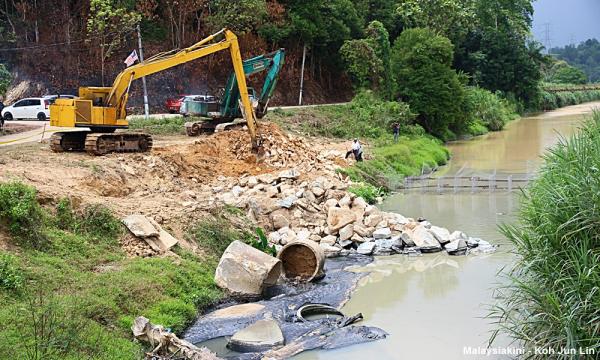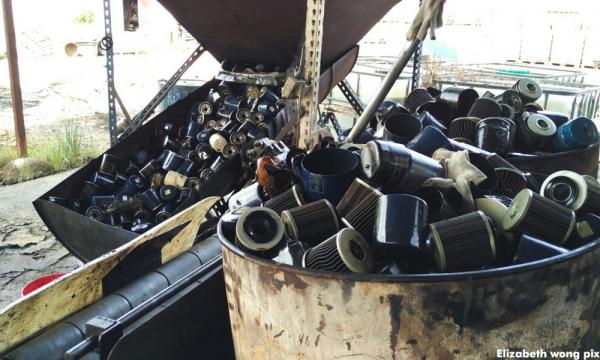The source of the Semenyih River is in Bukit Ulu Semenyih (450 meters above sea level). The estuary of Semenyih River is located in Jenderam Hilir. The Semenyih River has been used for domestic water consumption in Semenyih, Rinching City and Bandar Tasek Kesuma since 2005. The Semenyih River Basin has 36 branches and 25 water catchment basins which cover an area of 230.94 square kms.
The Semenyih River is the water source for the Semenyih Dam. The length of the river is 37 kilometres and it is divided into three stages, which are the river upstream, midstream and downstream. The Semenyih Dam and Semenyih Water Treatment Plant were built to accommodate treated water demand around Putrajaya, Petaling Jaya, Kuala Lumpur, the Klang Valley and Semenyih.
The Semenyih River is not only used for water supply to the population. The Tekala River, which is a tributary of the Semenyih River, has been a recreation centre for years because of the Tekala Waterfalls. The Tekala River is about 1km away, and the height is about 300 metres.
However, at the end of 2016, the Semenyih River Water Treatment Plant (WTP) had to be closed several times due to contamination of the Semenyih River.
Closure of the Semenyih River WTP has caused disruption in 450 areas in the district of Petaling like Petaling Jaya, Puchong, Seri Kembangan and the district of Hulu Langat such as Bangi, Bandar Bukit Mahkota, Kajang, Semenyih and Rinching; while the Kuala Langat district includes Morib, Banting, City Saujana Putra, Bandar Rimbayu and Telok Panglima.
Sepang district which covers Putrajaya, Cyberjaya, Bandar Nusa Putra, Putra Heights, Pulau Meranti, Kota Warisan, Bandar Bukit Puchong and Sungai Merab also faced water supply disruption.
Frequent closure of water treatment plants in a short period of time has caused anger and fury among the affected consumers and business people. Therefore, the non-governmental organisations (NGOs) such as the Federation of Malaysian Consumers Associations (Fomca), Forum Air Malaysia (FAM) and Water and Energy Consumers Association (Wecam) are taking the initiative to solve the problem in reducing the pollution of Semenyih River.
Fomca in cooperation with FAM and Wecam have made a site visit to the Semenyih River area. The outcome of the site visit shows that the source of the pollution of Semenyih River is from several areas such as the industrial zones, landfills, burial grounds and agricultural area. Most of these areas are located at the upstream of Semenyih River.
Whereas in Semenyih town, garbage can be found scattered all over such as in drains connected to rivers, roads and open areas. In the village area, it was found that residents living near the river throw their garbage into the river. Based on the results of site visit in Semenyih, it can be concluded that most of the people in Semenyih are not fully aware on the importance of the Semenyih River.
Awareness campaign
Therefore, in order to raise public awareness on the importance Semenyih River and improving the quality of Semenyih River, Fomca, FAM and Wecam will be conducting an awareness campaign for residents nearby Sungai Semenyih.
The campaign will last for three years and various activities will be carried out such as ‘gotong-royong’activities for cleaning Semenyih town area,‘Pertandingan Mengutip Sampah Paling Banyak’, an awareness programme for the public and school students in Semenyih and consultation sessions on alternative waste disposal for the industrial sector.
This awareness campaign will be a challenge to the residents, traders and manufacturers around Sungai Semenyih. The programme will raise public awareness about the consequences they will face if the river is polluted. The habit of littering the place indiscriminately can also be changed gradually. Furthermore, the awareness talks held in schools can strengthen their awareness on the importance of Sungai Semenyih.
The expectation of this programme is that if the level of awareness is increased then the level of pollution Semenyih River that would be lessened. In addition, the probability of water disruption cases due to water pollution will decrease because of the reduction of production waste into the river.
Meanwhile, with regard to the industry sector, efficient effluent management programmes will make many factories and industries along the Sungai Semenyih become more environmentally-friendly.
Such awareness programmes should also be carried out at the Langat River. This is because the Langat River also always gets contaminated. The Langat River is a main source of raw water to seven water treatment plants in Selangor, namely Sg Langat, Bukit Tampoi, Cheras Batu 11, Salak Tinggi, Sg Pangsoon, Sg Serai and Sg Lolo.
If the Langat River is contaminated then probably the seven water treatment plants would need to be closed temporarily, as had happened on Oct 8, 2016, where the Langat WTP and Cheras WTP had to be closed due to bad odour emanating from Semantan River, Pahang. The Semantan River is the source of raw water supply for Langat WTP and Cheras WTP.
Closure of the water treatment plant has resulted in disruption of water supply to several areas such as Cheras, Kuala Lumpur and Petaling district.
Although, Fomca, FAM and Wecam will take the initiative in raising public awareness about the importance of the river, the cooperation of all parties is very important for the success of an awareness campaign.
PROF DR MARIMUTHU NADASON is president, Federation of Malaysian Consumers Associations (Fomca).



